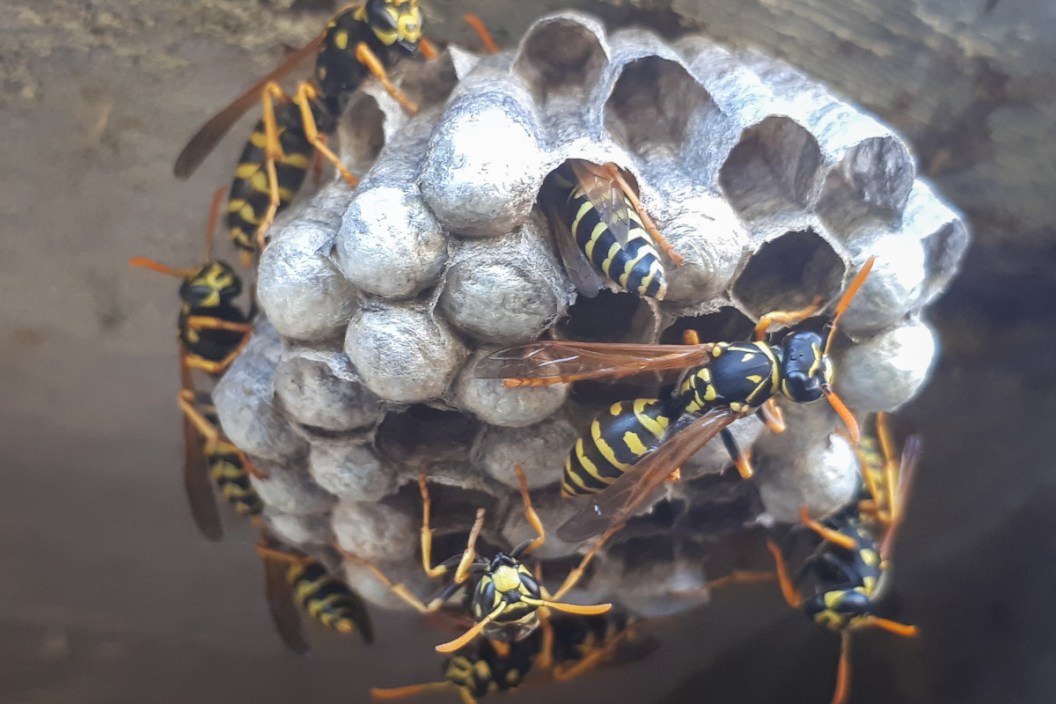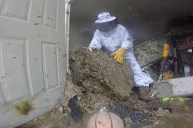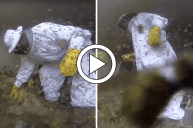What is the difference between hornets, wasps and bees?
Believe it or not, this question is more common than you might realize. Most people automatically think: "Stinging insects. Bad." We can't blame them. They've got nasty stings and often give us pest control headaches with household infestations.
But these flying insects are important pollinators and important parts of the food chain.
We'll explain a little more about the different species of bees, wasps and hornets of North America and what you need to know about these fascinating social insects when you encounter them.
Bees in the United States
The most commonly encountered bee here in the U.S. is going to be the honey bee, aka: Apis mellifera, if you want to get scientific. It's also known as the European honey bee because it was introduced to North America by some of the earliest settlers in the 1600s. They remain popular with beekeepers to this day.
These bees are colony insects. There is one queen bee and many worker bees. The worker bees are the ones that do all the work around the colony to produce honey and care for the larvae of young bees. One thing many people do not realize is only female bees sting. All worker bees are female, and the male bees or drone bees only live long enough to reproduce, and then they die.
Honey bees are very important because of how they pollinate as they gather nectar from various flowers and plants. It is little wonder scientists are concerned about recent developments where modern pesticides are causing some bee populations to die off.
These bees can sting and harm people if they are allergic. Bees can often only sting once because the stinging kills the insect. A barb literally rips the stinger out of the insect's body, and it doesn't survive the ordeal.
There are many different subspecies of bees living in the U.S., most of which produce honeycombs. Two of the more common ones you might happen across are carpenter bees, which are so named because they literally make their nests in wood.
The other common bee is the bumble bee, which make their homes in the ground usually. These bees are easy to differentiate from standard honeybees due to the size of the bumbles, which is huge. They make their homes underground.
Many people ask: "Do bumblebees sting?" The answer is a resounding yes, but generally, if you leave them alone, they won't bother you.
This is the point we should mention Africanized bees, also known as "killer bees." You may remember all the hype in the middle to late '90s about this aggressive variety that was produced by cross-breeding European bees and an African bee species. Biologists were trying to make a crossbreed a variety of bee in Brazil that would produce more honey all the way back in 1957.
But like a science fiction movie about an experiment gone wrong, it turns out the bees were more aggressive than normal bees. Once they escaped their bee hives in the '80s, they began spreading north. Fears really got out of hand in 1990 when Africanized bees were first found in Texas.
The fears are not totally unfounded. Africanized bees have killed hundreds of people, mostly through excessive stings. These bees will continue to chase people in large numbers, sometimes for miles if they're disturbed.
In the early '90s, there was a lot of doom and gloom forecast by many news programs. Many feared these bees would begin spreading and would build nests throughout the United States. Fortunately, most of the fears were unfounded. Killer bees are still a problem when they're found close to humans. However, a large new colony is rare, and they aren't quite the horror movie many scientists were predicting.
Wasps in the United States
Many people confuse many species of wasps with bees. To be fair, it's easy to do. They look very similar due to their coloration and often live in organized nests like bees. While some do feed on the nectar of plants like bees, it's more common to encounter predator wasps that eat other insects.
There are two different types of wasps. Solitary wasps are just what the names says, solitary insects that live on their own. Social wasps live in colonies and are the ones most often mistaken for bees. You've probably seen a paper wasp nest at some point while exploring the outdoors. It's a white or gray-colored nest that usually hangs in trees. But these wasps come into conflict with humans quite often when they make their nests on the eaves of houses or on backyard fences.
Another common species is Vespula germanica, aka: yellow jackets. They've got a nasty reputation for their sting and aggressive behavior when disturbed. The thing that makes this species annoying is how they nest underground. You often don't realize there's a nest around until you're getting swarmed.
A few years ago, I was geocaching in Ohio and my group stumbled upon a nest hidden in the ground on the edge of the forest. We all got a few stings from that one.
Holding an equally aggressive reputation is the red wasp. Another social wasp, they've got a sting to match. It doesn't help human/wasp relations that this species really likes constructing nests on man-made objects. One interesting aspect about this species is that they both collect nectar and are predatory.
As far as solitary wasps go, you've probably heard of the cicada killer wasp. Also known as the cicada hawk, (Sphecius speciosus), it's a solitary predator that got its name from, what else? Killing and feeding cicadas to their young.
One particularly horrifying thing about some wasp species is how their life cycle sometimes uses other insects as hosts for their young. Ever see the movie "Alien?" The real-life version exists in the insect kingdom!
One of the more well-known examples of this is the tarantula hawk wasp. This wasp catches and paralyzes a tarantula before laying an egg in the body of the host. When it hatches, the grub eats the tarantula from the inside out while it is still alive! And you thought the movies were far-fetched!
On another note, the tarantula hawk has what is considered to be one of the most painful stings on the planet. Just watch what one did to Coyote Peterson when he let it sting him if you don't believe us. We'll be avoiding this wasp like the plague!
In 2020, worries about Asian giant hornets invading the United States became a huge headline for several months. However, it now seems that most of the fears about "Asian Murder Hornets" were much like those of the Africanized bees, a lot of hyperbole. While there are genuine concerns about these bugs establishing a foothold in the states, there have been few confirmed sightings, and a lot of false identities. For now, let us hope that it does not get any worse than that.
Hornets in the U.S.
It may surprise some people to learn that there are few hornet species to be found in the U.S. A notable one is the European hornet. Technically, this is still a wasp species, as it's part of the family of wasps known as Vespa. The thing about hornets is that they can grow to huge sizes, which are immediately intimidating if one comes after you.
Much like many bees and wasps, these are colony insects that build their own homes. These hornets are sometimes a nasty surprise for loggers because the hornets like to build their nests in hollow tree trunks.
Another notable one is the bald-faced hornet (Dolichovespula maculate), a social wasp that grows to notably large sizes. This species makes huge paper nests that are often quite noticeable hanging from the branches of trees. In my hunting area, there's been a nest of these things hanging near where I set up one my trail cams for a few years now. The colony is dead, but the hornets' home has been surprisingly robust to the last few harsh Michigan winters.
These hornets are easy to pick out from other species due to their white markings.
Of course, many people fear hornets and it's understandable. These things are huge. Thankfully, hornet stings aren't considered to be too dangerous unless you have bad allergic reactions to insect stings.
Bee sting treatments
https://www.youtube.com/watch?v=6XMJBYXAp80
Even if you don't have allergies to stinging insects, it isn't a bad idea to know what to do in the event of a sting. It's amazing how many people I've encountered who don't know what to do for bee stings.
Many of these stings can be quite painful and uncomfortable, sometimes for up to 24 hours. Also consider the fact that you may find yourself in a situation with someone who IS allergic at some point. These same treatments can usually apply for wasp and hornet stings too.
First off, if you or someone you know has allergies, it's not a bad idea to have an epipen injector on hand whenever you're in the outdoors. This is one of those "better to have it and not need it than need it not have it" scenarios.
Remember that in some extreme cases, bee, wasp and hornet stings have caused anaphylactic shock and even death. An epipen could save your life or the life of someone you know.
If you're like me and are not allergic, you will still want to diffuse the pain from a sting. Even simple common wasp stings can be rather unpleasant. Personally, I carry a first aid kit in my vehicle that includes insect sting wipes. And yes, I have had to use them in the past during my outdoor adventures. They do help mitigate the pain significantly.
There are also products like Sting-Kill, which are swabs or wipes that will help eliminate the pain and swelling in a hurry. I recommend adding something like this to your boat, truck or RV if you don't already have it. They don't take up much room and when a sting happens, you'll be glad you have them.
There are also the numerous "home remedy" solutions to dealing with stings. One I've used in the past that I can tell you works is applying a little saltwater to the sting area. You can also try using toothpaste, baking soda, lavender, calamine, witch hazel or other oils. If you're out camping or fishing, you're probably going to have some ice on hand. I can tell you from experience it does help with the swelling. It's not the best treatment, but it's certainly better than nothing.
There's one last thing to keep in mind when treating stings. If you've suffered a honeybee sting, there is a good chance the stinger will still be embedded in you. Carefully remove it before you begin any treatments.
How to get rid of wasps, bees and hornets
If you own your own home, sooner or later you're likely going to have to deal with a wasp or hornet nest in your yard. Unfortunately, as we've mentioned before, some species like to build their nests on man-made objects. Even though many species of bees, wasps and hornets are beneficial insects that will help pollinate your garden and take care of pest insects, it becomes a problem when they set up shop on your kid's swing set.
First off, when trying to remove any bees, wasps or hornets, you should do your attack at night. These insects are much less active after the sun goes down and you want to catch them by surprise.
Wear heavy clothing that covers all exposed skin areas. Gloves and some type of face/head covering is essential.
Many modern insecticide sprays for bees, wasps and hornets are made to be quite potent. Manufacturers also finally realized the importance of making these things spray from a good distance away. This way, you don't have to put yourself in harm's way as much.
The video above is a good example of how to safely approach the problem. The man in the video uses a foaming-type spray. First, he hits the opening to the wasp nest and waits a few minutes. After that, he moves in and injects more spray into the nest directly from the side and lets it sit overnight. The next morning all the wasps are dead. Then all he had to do was clean up the mess they made.
Don't rush the removal of any nest. Think strategically about what you are going to do and how you are going to do it. Done properly, these bugs will never know what hit them.
If you're concerned about using an insect spray, there are some natural remedies floating around the internet. The video above has the guy using a combination of water, dish soap and peppermint to remove wasps from a greenhouse where they've set up shop. He uses this approach because his family is growing vegetables in the greenhouse and you don't want to use a poison spray around your dinner! You can also try a mixture of vinegar and water.
For ground nests, removal is incredibly simple. The guy in the video above puts a screen over the entrance to the nest at night and then drowns the wasps with a mixture of dish soap and water from the garden hose. Quick, easy, safe from chemicals and effective. Fill in the hole the next day and your wasp problem is taken care of.
Once the bees, hornets or wasps are dead, you'll want to take some precautions to be sure they don't return. Try spraying a mixture of soap and water or soap and peppermint in areas where they've been nesting.
Most experts agree, if you have a porch area or other place where the bugs keep getting in, do some work to seal up any cracks or holes where the insects can enter. There are also chemical sprays available in almost any home store that are meant to keep them away.
Two outside-the-box techniques I learned of only recently involve hanging a crumpled paper bag or a commercially-made wasp nest decoy in a problem area. The thinking behind this is that wasps are extremely territorial and will not start a new nest right next to an established one. I was a bit skeptical, but these products have fairly good reviews on Amazon, so take that as you will.
One final note on removal of nests: if you or someone in your family is allergic or if you suspect it's a hive of Africanized bees, it's probably best to call a professional. There's no shame in getting someone else to deal with the problem. Especially with Africanized bees. These bees have killed hundreds of people and removing them is best left to someone who really knows what they're doing.
For more outdoor content from Travis Smola, be sure to follow him on Twitter and check out his Geocaching and Outdoors with Travis YouTube channels.
NEXT: WHAT IS THE POWASSAN VIRUS, AND WHY DOES IT HAVE OUTDOORSMEN SCARED OUT OF THEIR WITS?
WATCH





